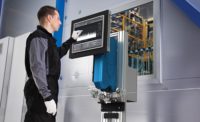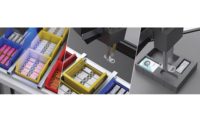System integration may seem complex. But the basic process is one that has been ongoing and evolving since a cave man first thought to attach a handle to a rock. The world of dimensional metrology has been undergoing a process of system integration in recent years that is significantly enhancing our ability to measure complex parts accurately and efficiently, and paving the way toward other, even more significant advances in the future. The process can be seen on three levels, beginning with the proliferation of universal metrology software platforms that have led to the development of multi-purpose, multi-function gages.
SOFTWARE
Universal operating software was originally designed as a modular, “smart” interface to all types of measurement systems that would simplify operator learning curves on different systems, and allow quick development of custom applications and routines. Newer versions have evolved to provide everything from simplification of the user interface for quick operation on the shop floor, to open interfaces that allow development of complex new parameters and measurement methodologies for dimensional metrology.
At base, these platforms have allowed us to essentially merge roughness, contour and form systems into one system, operated by a single piece of software. In principle, where one system used to go back and forth and measure surface roughness with a diamond stylus, it’s not that hard to imagine that something that turns around while touching the surface with a stylus can also measure roughness, as long as it’s got the same software. So the machines become just different shaped drive units that move and allow you to collect data. In the most abstract sense, it’s just a thing that holds a part and moves a probe.
HARDWARE
In practice, however, it wasn’t quite that simple, because just putting a surface finish probe on the old style form testers resulted in pretty lousy surface finish measurements. This is because form machines were designed to function differently from surface finish machines. When you measure surface roughness, you’re measuring small, high frequency stuff. When you’re measuring form, you’re measuring bigger errors, longer wavelength features or frequencies.
So a surface finish machine moves slowly and is very carefully designed to have low inherent vibration in the movement. But a form tester doesn’t need that. If you have some high frequency noise, it doesn’t really matter too much. It’s going to be filtered out anyway. Now, that doesn’t mean you’re going to make a sloppy device, but if you make a compromise in the design that allows it to move faster and carry heavier loads—at the expense of a little vibration, or residual noise in the measurement—you may be able to live with it in a form tester to achieve the performance you want.
But you can’t if you’re going to use that form tester for surface measurement. Also, if you’re measuring longer wavelength traces, you don’t need data points spaced quite as close together as with a surface measurement. The Nyquist sampling theorem says you need at least five data points per wavelength, so if you’re measuring shorter and shorter wavelengths, you need a lot more data points.
Thus, the new form testers included the electronics to support data points so close together; scales with fine resolution; the mechanics to make the machines quiet enough; and the controllers to drive them at the appropriate speeds. Integrating surface and form also opened the doors to entirely new measuring capabilities. We’ll look at several examples.
ROLLER BEARINGS
Many roller bearings have little cylindrical rollers in them. To the naked eye, the cylinders look like simple cylinders, but actually the contour of the surface is quite complex. The manufacturers want to make sure that loads are supported on the center of the roller, so they make the cylinders with a slight crown. Every bearing manufacturer defines this shape a little differently, along with the adjacent shapes and the radii at the ends.
A typical bearing manufacturer would have a spec that defines a section in the middle that is almost flat or with a large radius of curvature. Outside of that, the surface would curve, until at some point near the end, it would curve sharply and drop off the end. They need to carefully control that drop-off by a certain amount: not more than one amount and not less than another. To analyze these parts, we would define the nearly flat surface as being within X distance of the center point (or contact point with the mating part) and analyze this area for the radius of curvature. Then, at a certain distance in from each end, we measure the distance from that center point down to the surface and define it within another range and check this in order to control the roll-off near the ends.
Having integrated but open architecture software has allowed for programs to measure all of this with different machines in different ways for different manufacturers. Key to this was hardware that allowed measuring both short and long wavelengths on one system.
VALVE STEMS AND SEATS, CYLINDER WALLS AND MORE
The second level of integration involves systems designed to hold the gage so it can be easily brought to the part. One example was to measure both surface finish and contour on valve seats and other areas on large diesel engine heads. The system utilized a granite table and a custom air flotation/rotation fixture to facilitate positioning the probe relative to the part. However, the valve seats were only accessible through a small hole, and the manufacturer wanted the system to check the relief angle at the top, the conical angle of the seat area, another relief angle at the bottom, and the surface finish on the contact area.
Fortunately, this case was not unlike a number of other projects where we’ve been able to take a standard measuring device, and package it up in a way that makes it fit the application so you just insert the package in the part—in this case we protected the probe with a small mandrel—hit start, and it measures.
FAIL-SAFE FIXTURING
One recent application started out more like a detective story. The customer wanted a roundness gage that could also measure surface finish, but they couldn’t tell us anything about the application. It was “top secret,” they said, “a futuristic product with all kinds of interesting characteristics,” but they couldn’t tell us about them. All they would tell us was that they needed to measure several different step heights and surface textures at several different points on these “sort of round” parts. It made the selling process rather interesting.
It was only after they bought a machine that they began telling us about all the things they thought they wanted to measure on these parts. That’s when the questions began: “How are you going to hold these parts?” we asked. “We’re just going to put them in a three-jawed chuck.” “Okay. Then how are you going to reach these surfaces and these surfaces since you don’t have access to both?”
It quickly became apparent that they needed a fixturing system that would hold the parts and allow the various surfaces to be accessible. We were able to custom-design a number of mounting fixtures that staged each of their parts.
MATHEMATICAL MODELS
But fixturing was only the beginning. As we started to write programs to measure these various surfaces, we kept running into these strange call-outs on the drawings, oddly textured surfaces, strange run-outs and step heights.
Eventually, we learned that the product development folks were putting on the drawings what they had been told was the only thing anyone could measure, because they didn’t think what they actually wanted could be measured. And when we asked what it was they really wanted, they said, “Well, we want this series of arcs to basically conform to a Fibonacci sequence, like a conch shell spiral.” “Well,” we said, “If you can define it mathematically, we can probably find a way to analyze it.”
As it turned out, they didn’t really want a Fibonacci spiral. That was the ideal of the designer, but manufacturing couldn’t figure out how to make it. Instead, they were making these parts using involute profiles similar to those used in gear manufacturing. What they didn’t realize was that there are well-understood mathematics in the world of gears on how to analyze involute profiles. So while there was no off-the-shelf metrology system that would analyze the kind of parts and the kind of measurements they had, we were able to put a few twists on known concepts and provide them with the ability to measure what they were manufacturing better than they had imagined they could.
Unfortunately, the application is too proprietary to discuss in any depth. Suffice it to say we were able to combine surface finish measurement with form measurement, and some things that involved the form analysis of shapes that don’t conform to typical standards, but were defined mathematically. Universal software allowed these “non-traditional” profiles to be analyzed according to accepted standards for surface parameters. It was a first.
FUTURE FORM AND SURFACE ANALYSIS
To me, the project also represented one of the things it’s important for us to understand in metrology. We’re used to devices that move back and forth or turn around in circles. But many of the things we’re making these days aren’t flat or round, like these strange, proprietary parts, or the multitude of orthopedic implants that go into human bodies. They have interesting and unique shapes. What we can do for measurement today is a small subset of what the world is going to need in the future.
Recently I attended a symposium on surface finish at the Worcester Polytechnic Institute. The keynote speaker, Richard Leach from Britain’s National Physical Laboratory (similar to NIST here in the United States), said that today our understanding of surface finish is in terms of frequencies and wavelengths in two dimensions. That’s not wrong, he said, but in the future we would need to understand the function of 3-D structures on surfaces that are of different scales—not just different wavelengths—and we would need to be able to take them apart and analyze them.
The example he gave was of a chameleon: why is a chameleon able to walk across a ceiling? If you look at their paws, they have different structures. On the big scale, they have their fingers. On the medium scale they have little suction cups that are able to grab the surface. And on the really fine scale, on the texture of the suction pads are these things that allow them to adhere to a surface and not fall in a vertical direction, but easily release when they move sideways. So it’s not just a suction cup, but one that can easily be picked up sideways. There are many structures that have evolved in nature to perform complex functions on different scales, and as we learn to create engineered 3-D surfaces in the future, we’ll need to be able to think like that: not only to construct surfaces with different functionality on different scales, but in metrology, to be able to take those surfaces apart with our analytical methods and measure them to ensure they perform the desired function.
Pat Nugent is vice president of metrology systems at Mahr Federal Inc. (Providence, RI). For more information, call (800) 343-2050, email [email protected] or visit www.mahr.com.








